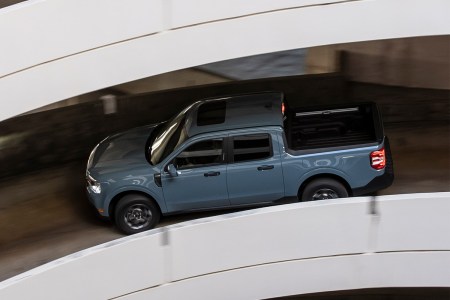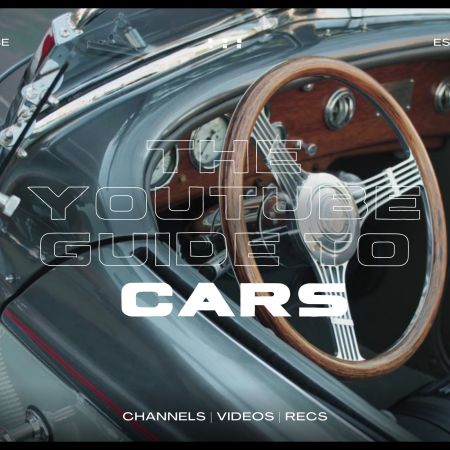Hybrid drivetrains have been a core part of Toyota’s brand for the past two decades, but until very recently they’ve been noticeably missing from the automaker’s truck lineup. The full-size Tundra added battery assistance for the 2022 model year, and now the splashy redesign of the midsize Tacoma has gone the same route.
The 2024 Toyota Tacoma’s i-Force Max hybrid drivetrain is the first in its class, pushing it to the top of the pack when it comes to power. If you’re looking for similarly robust fuel economy from the battery-boosted truck, however, you’ll be disappointed: although there are mild gains to be made, the Tacoma’s additional electrons are more focused on adding muscle than increasing mileage.
| Vehicle | 2024 Toyota Tacoma |
| Trim Tested | Limited i-Force Max |
| Starting Price | $31,500 |
| Price of Model Tested | $57,295 (including destination) |
| Vehicle Type | Four-door hybrid pickup |
| Engine | i-Force Max 2.4L turbocharged 4-cylinder, 326 hp and 465 lb-ft of torque |
| Fuel Economy | 23/24/24 mpg |
Thus, customers in search of a midsize truck are being asked to make a choice: do you stay with the tried and true turbo fours provided by nearly every other option from Ford, Chevrolet and GMC (as well as the non-hybrid Tacomas), or do you roll the dice on the extra complication of Toyota’s hybrid design in seeking out class-leading torque? And while you’re at it, should you investigate the brand’s luxury Limited trim in the process?
I spent a week behind the wheel of the 2024 Toyota Tacoma Limited i-Force Max to find out.

Big Power, Small Engine
Toyota’s hybrid offering is restricted to four-door models at the top half of the Tacoma lineup, which means it’s available in street performance (TRD Sport), off-road (TRD Off-Road, Trailhunter, TRD Pro) and premium (Limited) trim levels. Every other edition of the Tacoma is outfitted with a turbocharged four-cylinder motor that doesn’t benefit from a battery.
The spec sheet appeal of the i-Force Max — which adds a single electric motor to that same turbo engine, smooshed between the block and the transmission — is easy to understand. With 326 horsepower and 465 lb-ft of torque available in the Limited, the Tacoma vaults to the front of the pack, bypassing high-output versions of GM and Ford’s respective turbocharged four-cylinders, as well as Nissan’s V6 and the twin-turbo V6 offered by the desert-running Ford Ranger Raptor.
Americans Are Obsessed With the Wrong Trucks
For decades, pickup buyers have believed bigger is better. The Ford Maverick Hybrid proves the opposite.Managed by an eight-speed automatic gearbox, the Limited also offers a full-time four-wheel drive system (as opposed to the part-time transfer case found in every other i-Force Max implementation). This accounts for at least some of its modest fuel economy boost: Rated at 24 mpg on the highway, it’s about two miles per gallon better than its closest midsize competitor. That’s perfectly acceptable for a pickup truck, but it’s a long way from the 30 mpg available from past turbo-diesel engines found in the Chevrolet Colorado and the GMC Canyon, which remain the reigning champs of fuel-pump frugality.

Easily Outclassing Past Tacoma Engines
Spool that turbo, drain that battery, and trust me, you won’t be missing the thrashy mid-grade performance of the now-departed V6 that was once the top option in the Tacoma. Acceleration is brisk off the line and once underway there’s no lack of passing power, as I discovered on the occasionally tourist-clogged two-lane roads that lead to my home deep in prime leaf-peeping country. I was also able to match Toyota’s highway fuel economy without making any special effort, which isn’t always the case when dealing with a heavy hybrid like this one.
Eager to explore other aspects of the Tacoma’s mission, I put it to work hauling two loads of wood chips from the local sawmill to my garden, each of which weighed well over a thousand pounds. Maybe if I had a longer box — a five-footer is the only available cargo option on the Limited — I could have done it all in one go, but the drivetrain never complained and the truck’s comfort-oriented coil spring rear suspension didn’t bend under the weight.
It was a similar story when I hooked up 4,000 pounds of race car and trailer and took a 100-mile jaunt through the mountains to see how well the Toyota could tow. Although I wished for larger mirrors to go with the truck’s towing package, it handled the weight like a champ, and the extra maneuverability of the right-size platform made it much easier to get in and out of tighter parking situations with the Tacoma as compared to some full-size pickups I’ve recently hauled with.

Quality Concerns for a First-Year Hybrid
Undercutting much of the above performance was a nagging vibration from the front end of the Toyota Tacoma that made itself known during our entire time together. Particularly prominent at engine speeds of 2,000 rpm or less, the grinding sensation had me concerned that there was something wrong with the hybrid system, or perhaps the coupler for the four-wheel drive. Toyota currently has a replacement bulletin out for the eight-speed automatic for a certain range of Tacomas, and while I had no check engine lights on, it’s possible the transmission was the problem. The issue only got worse when the stress of towing was added to the mix, despite power never dropping and the truck not displaying any check engine lights or error messages.
This is a problem for a first-year product like the Tacoma i-Force Max, and it’s an even bigger issue when considering that the Limited model comes with a fairly hefty starting price of $55,800. For that money, Toyota intends to offer a full-on premium experience, and the lack of smoothness from the hybrid didn’t support that effort.
Neither did the Tacoma’s interior. To be fair, everything about the cabin was perfectly acceptable by pickup truck standards, and the large 14-inch infotainment screen was even a bit of a standout. The trim and materials throughout the interior, however, never rose to the level suggested by the Limited’s price point, and didn’t match what’s on offer in the GMC Canyon Denali, another recent (and similarly priced) attempt at outfitting a midsizer with class-above trappings.

Solving the Midsize Equation
There’s plenty of power and legitimate capability on offer from the 2024 Toyota Tacoma Limited. Still, the i-Force Max’s exceptional output would have impressed me more were I not worried about a potential failure due to its harshness and vibration. Then there’s the price: there’s simply not enough going on with the Tacoma Limited’s feature set to recommend the extra spend.
Technical issues with the otherwise mighty and thrifty powertrain aside, it seems as though Toyota has run into the same problem every other brand in the midsize segment has encountered when trying to build a premium truck. It’s hard not to feel like companies are saving their best technologies and designs to lure prospective customers into purchasing more profitable full-size models, giving their extremely useful and much easier to drive midsize editions a short shrift.
That being said, there’s no doubt in my mind that the overall Tacoma platform is overall better, quieter and more comfortable thanks to this latest revision. If you’re not deterred by the first-year jitters and are laser-focused on snagging the hybrid, it’s available for about $10,000 less in both the Sport and the TRD Off-Road trims, where it’s a more compelling choice — especially if you’re more concerned about putting the truck to work than you are showing off its shinier bits.
This article was featured in the InsideHook newsletter. Sign up now.
























